Santa Rosa, California, Hgh State Clinic, Hgh Injections, Hrt Doctors
Santa Rosa, California Blood Testing Facilities
 Represents a LabCorp blood testing facility
Represents a LabCorp blood testing facility Represents a Quest Diagnostics blood testing facility
Represents a Quest Diagnostics blood testing facility

Nearby Labcorp Blood Testing facilities:
- Labcorp Center Distance: 0 m, 1111 Sonoma Ave Ste 121, Santa Rosa, Sonoma County, CA, 95405
- Labcorp Center Distance: 2 m, 3540 Mendocino Ave Ste 400, Santa Rosa, Sonoma County, CA, 95403
- Labcorp Center Distance: 6 m, 1370 Medical Center Dr Ste B, Rohnert Park, Sonoma County, CA, 94928
- Labcorp Center Distance: 8 m, 8465 Old Redwood Hwy Ste 400, Windsor, Sonoma County, CA, 95492
- Labcorp Center Distance: 13 m, 153 Lynch Creek Way, Petaluma, Sonoma County, CA, 94954
- Labcorp Center Distance: 14 m, 999 Adams St. Suite 501, Saint Helena, Napa County, CA, 94574
- Labcorp Center Distance: 24 m, 3448 Villa Lane Suite 103, Napa, Napa County, CA, 94558
- Labcorp Center Distance: 35 m, 1321 S. Elisio Drive, Greenbrae, Marin County, CA, 94904
- Labcorp Center Distance: 37 m, 150 Glen Cove Marina Rd. 105, Vallejo, Solano County, CA, 94591
- Labcorp Center Distance: 39 m, 2089 Vale Rd Ste 14, San Pablo, Contra Costa County, CA, 94806
- Labcorp Center Distance: 40 m, 1367 East Second Street, Benicia, Solano County, CA, 94510
- Labcorp Center Distance: 44 m, 1228 Solano Ave, Albany, Alameda County, CA, 94706
- Labcorp Center Distance: 46 m, 55 Francisco St. Suite 430, San Francisco, San Francisco County, CA, 94133
- Labcorp Center Distance: 47 m, 728 Pacific Ave. Suite 401, San Francisco, San Francisco County, CA, 94133
- Labcorp Center Distance: 48 m, 148 Noe Street, San Francisco, San Francisco County, CA, 94114
- Labcorp Center Distance: 49 m, 3466 Mt. Diablo Blvd.Ste C-102, Lafayette, Contra Costa County, CA, 94549
- Labcorp Center Distance: 50 m, 2622 Ocean Ave., San Francisco, San Francisco County, CA, 94132
- Labcorp Center Distance: 51 m, 500 Lennon Lane, Walnut Creek, Contra Costa County, CA, 94598
- Labcorp Center Distance: 52 m, 1220 Rossmoor Parkway, Walnut Creek, Contra Costa County, CA, 94598
- Labcorp Center Distance: 54 m, 2220 Gladstone Dr. Suite 7, Pittsburg, Contra Costa County, CA, 94565
- Labcorp Center Distance: 58 m, 907 San Ramon Valley Blvd 102, Danville, Contra Costa County, CA, 94526
- Labcorp Center Distance: 59 m, 4045 Lone Tree Way Ste B, Antioch, Contra Costa County, CA, 94531
- Labcorp Center Distance: 61 m, 2305 Camino Ramon Ste 110, San Ramon, Contra Costa County, CA, 94583
- Labcorp Center Distance: 64 m, 2400 Balfour Rd. Suite 100, Brentwood, Contra Costa County, CA, 94513
- Labcorp Center Distance: 65 m, 27171 Calaroga Ave. Suite 6, Hayward, Alameda County, CA, 94545
- Labcorp Center Distance: 67 m, 5860 Owens Dr. Suite 120, Pleasanton, Alameda County, CA, 94588
- Labcorp Center Distance: 69 m, 4125 Mohr Ave. Suite Am, Pleasanton, Alameda County, CA, 94566
- Labcorp Center Distance: 70 m, 8100 Timberlake Way Ste E, Sacramento, Sacramento County, CA, 95823
- Labcorp Center Distance: 71 m, 1048 El Camino Real Suite B, Redwood City, San Mateo County, CA, 94063
- Labcorp Center Distance: 72 m, 2147 Mowry Ave Ste C1, Fremont, Alameda County, CA, 94538
- Labcorp Center Distance: 73 m, 1018-A Murrieta Blvd., Livermore, Alameda County, CA, 94550
- Labcorp Center Distance: 75 m, 853 Middlefield Rd Ste 6, Palo Alto, Santa Clara County, CA, 94301
- Labcorp Center Distance: 77 m, 6620 Coyle Ave Ste 109, Carmichael, Sacramento County, CA, 95608
- Labcorp Center Distance: 81 m, 2500 Hospital Dr Bldg 11, Mountain View, Santa Clara County, CA, 94040
- Labcorp Center Distance: 82 m, 901 W. El Camino Real, Sunnyvale, Santa Clara County, CA, 94087
- Labcorp Center Distance: 83 m, 1617 N. California Street, Stockton, San Joaquin County, CA, 95204
- Labcorp Center Distance: 84 m, 1008 Riley St Ste 4, Folsom, Sacramento County, CA, 95630
- Labcorp Center Distance: 86 m, 1600 Creekside Dr Ste 3500, Folsom, Sacramento County, CA, 95630
- Labcorp Center Distance: 87 m, 316 Rosewood Ave. 2Nd Floor, San Jose, Santa Clara County, CA, 95117
- Labcorp Center Distance: 88 m, 266 N Jackson Ave Ste 4, San Jose, Santa Clara County, CA, 95116
- Labcorp Center Distance: 89 m, 50 E. Hamilton Ave. Suite 80, Campbell, Santa Clara County, CA, 95008
- Labcorp Center Distance: 90 m, 777 Knowles Dr Ste 4, Los Gatos, Santa Clara County, CA, 95032
- Labcorp Center Distance: 92 m, 2060 Aborn Rd Ste 200, San Jose, Santa Clara County, CA, 95121
- Labcorp Center Distance: 93 m, 11930 Heritage Oak Pl Ste 7, Auburn, Placer County, CA, 95603
- Labcorp Center Distance: 95 m, 393 Blossom Hill Rd Ste 350, San Jose, Santa Clara County, CA, 95123
- Labcorp Center Distance: 96 m, 6489 Camden Ave Ste 107, San Jose, Santa Clara County, CA, 95120
Nearby Quest Blood Testing facilities:
- Quest Center Distance: 0 m, 990 Sonoma Ave, Santa Rosa, Sonoma County, CA, 95404-4813
- Quest Center Distance: 13 m, 1550 Professional Drive, Petaluma, Sonoma County, CA, 94954-6655
- Quest Center Distance: 24 m, 3260 Beard Road, Napa, Napa County, CA, 94558-3406
- Quest Center Distance: 35 m, 1000 S Eliseo Dr, Greenbrae, Marin County, CA, 94904-2133
- Quest Center Distance: 37 m, 1411 Oliver Road, Fairfield, Solano County, CA, 94534-3424
- Quest Center Distance: 40 m, 770 Mason St, Vacaville, Solano County, CA, 95688-4648
- Quest Center Distance: 47 m, 2201 Post St, San Francisco, San Francisco County, CA, 94115-3427
- Quest Center Distance: 48 m, 401 Gregory Ln, Pleasant Hill, Contra Costa County, CA, 94523-2836
- Quest Center Distance: 49 m, 2198 15Th St, San Francisco, San Francisco County, CA, 94114-1213
- Quest Center Distance: 51 m, 108 La Casa Via, Walnut Creek, Contra Costa County, CA, 94598-3013
- Quest Center Distance: 53 m, 2111 Whitehall Place, Alameda, Alameda County, CA, 94501-6160
- Quest Center Distance: 54 m, 1837 E Gibson Rd, Woodland, Yolo County, CA, 95776-5168
- Quest Center Distance: 55 m, 901 Campus Dr, Daly City, San Mateo County, CA, 94015-4930
- Quest Center Distance: 60 m, 120 S El Camino Real, Millbrae, San Mateo County, CA, 94030-3133
- Quest Center Distance: 61 m, 20400 Lake Chabot Rd, Castro Valley, Alameda County, CA, 94546-5314
- Quest Center Distance: 64 m, 1241 East Hillsdale Blvd, Foster City, San Mateo County, CA, 94404-0000
- Quest Center Distance: 65 m, 7248 South Land Park Drive, Sacramento, Sacramento County, CA, 95831-3661
- Quest Center Distance: 67 m, 5720 Stoneridge Mall Road, Pleasanton, Alameda County, CA, 94588-2851
- Quest Center Distance: 69 m, 1100 Laurel Street, San Carlos, San Mateo County, CA, 94070-5000
- Quest Center Distance: 70 m, 8191 Timberlake Way, Sacramento, Sacramento County, CA, 95823-5418
- Quest Center Distance: 71 m, 2288 Auburn Boulevard, Sacramento, Sacramento County, CA, 95821-1619
- Quest Center Distance: 72 m, 1090 E Stanley Blvd, Livermore, Alameda County, CA, 94550-4157
- Quest Center Distance: 76 m, 7423 Fair Oaks Blvd, Carmichael, Sacramento County, CA, 95608-1797
- Quest Center Distance: 80 m, 1708 W Hammer Ln, Stockton, San Joaquin County, CA, 95209-2922
- Quest Center Distance: 81 m, 205 South Dr, Mountain View, Santa Clara County, CA, 94040-4323
- Quest Center Distance: 82 m, 649 E Calaveras Blvd, Milpitas, Santa Clara County, CA, 95035-7708
- Quest Center Distance: 83 m, 877 W Fremont Avenue, Sunnyvale, Santa Clara County, CA, 94087-2332
- Quest Center Distance: 84 m, 632 West 11Th Street, Tracy, San Joaquin County, CA, 95376-3856
- Quest Center Distance: 86 m, 1600 Creekside Drive, Folsom, Sacramento County, CA, 95630-3445
- Quest Center Distance: 87 m, 123 Disalvo Ave, San Jose, Santa Clara County, CA, 95128-1717
- Quest Center Distance: 88 m, 2618 Alum Rock Ave, San Jose, Santa Clara County, CA, 95116-2621
- Quest Center Distance: 89 m, 840 Willow St, San Jose, Santa Clara County, CA, 95125-2384
- Quest Center Distance: 91 m, 2365 Quimby Rd, San Jose, Santa Clara County, CA, 95122-1337
- Quest Center Distance: 92 m, 2581 Samaritan Drive, San Jose, Santa Clara County, CA, 95124-4112
- Quest Center Distance: 93 m, 3133 Professional Drive, Auburn, Placer County, CA, 95603-2463
- Quest Center Distance: 95 m, 670 Oro Dam Blvd E, Oroville, Butte County, CA, 95965-5746
Santa Rosa California Hormone Replacement Therapy Services
The Conscious Evolution Institute is a proud and reputable provider of quality HRT Services throughout the Santa Rosa Metropolitan Area. Hormone Restoration and Optimization have been recognized in recent years as key components to any quality health and wellness program, and our Licensed and Board-Certified Hormone Clinic operates with that in mind. If you are 30 years of age or older, you may qualify for one of the many quality HRT Treatments that we provide, such as HGH Injections or Testosterone Therapy.
We have made the process of Hormone Deficiency diagnosis and treatment easier than ever, because we have affiliate medical physicians located all throughout Santa Rosa and all of California which we utilize in order to maximize the efficiency of our Hormone Clinic without sacrificing quality of care or inflating the cost of treatment. With just a routine physical and blood sample, our highly trained and qualified Hormone Specialists can take your medical information and provide you with a detailed diagnosis with which to design an HRT Regimen which fits both your needs and your budget. If you feel like you may be a viable candidate for Hormone Restoration, we strongly urge you to consider having your Hormone Levels checked by a professional like those at the Conscious Evolution Institute, so that you don't deny yourself the potentially life-changing treatments that we have to offer!
HGH Clinics in Santa Rosa California
Most people are aware of Human Growth Hormone Injections, but only because of their use as Performance Enhancing Drugs. Unfortunately, the stigma associated with Bio-Identical HGH has prevented many people from learning about the real benefits of Growth Hormone for patients with clinically diagnosed Hypopituitarism. Age-Related HGH Deficiency is a common medical condition among men and women thirty years and older. With every year after the age of thirty, a patient is more likely to experience the disorder.
Because Human Growth Hormone Deficiency is central to healthy cellular metabolism, Low HGH Levels are directly correlated with a wide variety of issues which can severely reduce both quality of life and overall health. For patients with Clinically Diagnosed Growth Hormone Deficiency, Recombinant Injectable HGH has been shown to increase waning muscle mass, contribute to weight loss, improve immune health and healing capacity, alleviate minor depression, and more. HGH is delivered in daily injections, and significant symptom relief generally occurs over the course of four to six months of treatment (though many symptoms see relief much earlier in the therapeautic process..
Sermorelin HGH Treatments for Residents of Santa Rosa California
Of course, Growth Hormone Shots are not the only method to revitalize waning natural Growth Hormone Production. Sermorelin Acetate Therapy is another treatment which has been proven to enhance natural HGH Levels, restoring them to levels associated with youthful vitality. Sermorelin is able to achieve this goal because it replicates the function of GH-RH, the immediate precursor of Human Growth Hormone which is released by the Hypothalamus to stimulate Somatotrophic secretion of HGH. Sermorelin has a lower risk of overdose than Human Growth Hormone while also more naturally preserving the biological rhythms of the human body. Call us today to ask about the benefits of Sermorelin vs. Human Growth Hormone.
Testosterone Creams, Injections and Patches in Santa Rosa California
The more that we learn about Low-T, the more dangerous that we recognize that the condition is to male health. Where Testosterone Deficiency was first considered primarily a sexual disorder, it is now apparent that Hypogonadism can severely impact a man's life in ways that can impede wellness and significantly increase mortality risk. Luckily, recent studies have shown that Physician-Mediated Testosterone Restoration can limit these risks, while also increasing sexual vitality and potency.
If you have been experiencing issues related to sexual inadequacy, including low sex drive and erectile dysfunction, quality Prescription Testosterone Products can help improve your sex life while also improving your overall health in a variety of ways. Men with Testosterone Deficiency are more likely to be overweight, fatigued, and plagued by muscle weakness. They are also more likely to suffer from lfe-threatening cardiovascular conditions ranging from atherosclerosis to heart disease. If you'd like to learn more about how Low-T Therapy can help enhance your life, please contact us today!
Santa Rosa California Information
Santa Rosa is a major city located on the edge of the San Francisco Metropolitan area, just over 50 miles away from the City by the Bay. Santa Rosa is highly notable for being the heart of the California Wine Country, which is world-renowned for its prowess at producing wines of the highest quality. The Santa Rosa area is also known as the North Bay, the northern region of the greater San Francisco Bay Area.
The North Bay is among the least populous areas in the San Francisco metropolitan area, while also maintaining a high quality of life. Many people also visit the Santa Rosa area to experience nearby parks such as Sugarloaf Ridge State Park, Annadel State Park, and the Austin Creek State Recreation Area. Santa Rosa acts as a major staging area for tourists from all over America that come to visit the wineries and scenic views of the North Bay. Major tourist attractions include the massive redwoods of the Armstrong Redwoods State Reserve, the beautiful beaches of the Sonoma Coast, and the Russian River Resort.
Neighborhoods in Santa Rosa include the West End Art and Theater District, Rincon Valley, Olive Park, Hidden Valley, Fountaingrove, Cherry Street, Burbank Gardens, and Bennett Valley. Among the suburbs of Santa Rosa are Fulton, Mark West Springs (Notable for being the home of the famous Mark West Winery), Rohnert Park, Forestville, and Kenwood. Major employers in Santa Rosa include Amy's Kitchen, Keysight, and Kaiser Permanente (which is one of the largest care-facilities in the United States).
All About Santa Rosa, California Geographic Area
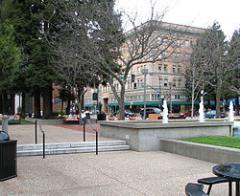
Santa Rosa is the county seat of Sonoma County, California United States. The 2010 census reported a population of 167,815. Santa Rosa is the largest city in California's North Coast, Wine Country and the North Bay; the fifth most populated city in the San Francisco Bay Area after San Jose, San Francisco, Oakland, and Fremont; and the 26th most populated city in California.
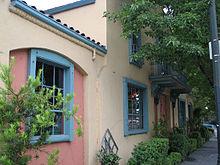
The first known permanent European settlement of Santa Rosa was the homestead of the Carrillo family, in-laws to Mariano Guadalupe Vallejo, who settled the Sonoma pueblo and Petaluma area. In the 1830s, during the Mexican period, the family of MarRa LR³pez de Carrillo built an adobe house on their Rancho Cabeza de Santa Rosa land grant, just east of what later became downtown Santa Rosa. Allegedly, however, by the 1820s, before the Carrillos built their adobe in the 1830s, Spanish and Mexican settlers from nearby Sonoma and other settlements to the south raised livestock in the area and slaughtered animals at the fork of the Santa Rosa Creek and Matanzas Creek, near the intersection of modern-day Santa Rosa Avenue and Sonoma Avenue. This is supposedly the origin of the name of Matanzas Creek as, because of its use as a slaughtering place, the confluence came to be called La Matanza.
By the 1850s, a Wells Fargo post and general store were established in what is now downtown Santa Rosa. In the mid-1850s, several prominent locals, including Julio Carrillo, son of Maria Carrillo, laid out the grid street pattern for Santa Rosa with a public square in the center, a pattern which largely remains as the street pattern for downtown Santa Rosa to this day despite changes to the central square, now called Old Courthouse Square.
In 1867, the county recognized Santa Rosa as an incorporated city and in 1868 the state officially confirmed the incorporation, making it officially the third incorporated city in Sonoma County, after Petaluma, incorporated in 1858, and Healdsburg, incorporated in 1867.
The U.S. Census records, among others, show that after California became a state, despite initially lagging behind nearby Petaluma in the 1850s and early 1860s, Santa Rosa grew steadily early on. According to the U.S. Census, in 1870 Santa Rosa was the eighth largest city in California, and county seat of one of the most populous counties in the state. Growth and development after that were never rapid, but were steady. As a result, the city continued to grow when other early population centers declined or stagnated, but by 1900 it had been, or was being, overtaken by many other newer population centers in the San Francisco Bay Area and Southern California. According to a 1905 article in the Press Democrat newspaper reporting on the "Battle of the Trains", the city had just over 10,000 people at the time.
The April 18, 1906 San Francisco Earthquake essentially destroyed the entire downtown, but the city's population did not greatly suffer. However, after that period the population growth of Santa Rosa, as with most of the area, was very slow.
Famed director Alfred Hitchcock filmed his thriller Shadow of a Doubt in Santa Rosa in 1943; the film, which has been released on VHS and DVD, gives glimpses of Santa Rosa in the 1940s. Many of the downtown buildings seen in the film no longer exist due to major reconstruction following the strong earthquakes in September 1969. However, some, like the rough-stone Northwestern Pacific Railroad depot and the prominent Empire Building (built in 1910 with a gold-topped clock tower), still survive. A scene at the bank was filmed at the corner of Fourth Street and Mendocino Avenue (at present day Old Courthouse square); sharp-eyed viewers can also identify the "KRESS" building on Fourth Street. However, the courthouse and bank are now gone.
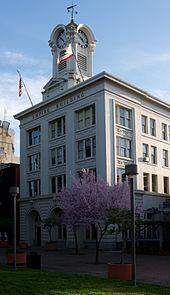
Santa Rosa grew following World War II. The city was a convenient location for San Francisco travelers bound for the Russian River.
The population enlarged by 2/3 between 1950 and 1970, an average of 1,000 new residents a year over the 20 years. Some of the increase was from immigration, and some from annexation of portions of the surrounding area.
In 1958 the United States Office of Civil and Defense Mobilization designated Santa Rosa as one of its eight regional headquarters, with jurisdiction over Region 7, which included American Samoa, Arizona, California, Guam, Hawaii, Nevada, and Utah. Santa Rosa continued as a major center for civil defense activity (under the Office of Emergency Planning and the Office of Emergency Preparedness) until 1972 when the Federal Emergency Management Agency (FEMA) was created in its place, ending the civil defense's 69-year history.
When the City Council adopted the City's first modern General Plan in 1991, the population was about 113,000. In the 21 years since 1970, Santa Rosa had grown by about 3,000 residents a year aetriple the average growth during the previous twenty years.
Santa Rosa 2010, the 1991 General Plan, called for a population of 175,000 in 2010. The Council expanded the City's urban boundary to include all the land then planned for future annexation, and declared it would be Santa Rosa's "ultimate" boundary. The rapid growth that was being criticized as urban sprawl became routine infill development.
At the first five-year update of the plan, in 1996, the Council extended the planning period by ten years, renaming it Vision 2020 (updated to Santa Rosa 2020, and then again to Santa Rosa 2030 Vision), and added more land and population. Now the City projects a population of 195,000 in 2020.
Santa Rosa is located at 38 °26 a²55 a³N 122 °42 a²17 a³W / 38.448611 °N 122.704722 °W / 38.448611; -122.704722 in Sonoma County. According to the United States Census Bureau, the city has a total area of 41.50 sq mi (107.5 km2), of which 41.29 sq mi (106.9 km2) is land and 0.205 sq mi (0.5 km2) (0.49%) is water.
The city is part of the North Bay region, which includes such cities as Petaluma, Rohnert Park, Windsor, and smaller cities as Sonoma, Healdsburg, Sebastopol. It lies along the US Route 101 corridor, approximately 55 miles (89 km) north of San Francisco, via the Golden Gate Bridge.
Santa Rosa lies on the Santa Rosa Plain; its eastern extremities stretch into the Valley of the Moon, and the Sonoma Creek watershed known as the Sonoma Valley, while its western edge lies in the Laguna de Santa Rosa catchment basin.
The city is in the watershed of Santa Rosa Creek, which rises on Hood Mountain and discharges to the Laguna de Santa Rosa. Tributary basins to Santa Rosa Creek lying significantly in the city are Brush Creek, Matanzas Creek, Colgan Creek and Piner Creek. Other water bodies within the city include Fountaingrove Lake, Lake Ralphine, and Santa Rosa Creek Reservoir.
The prominent visual feature is Hood Mountain seen to the east. To the southeast, Taylor Mountain and Sonoma Mountain are readily visible from much of the city.
Santa Rosa has a Mediterranean climate with cool, wet winters and warm, mostly dry summers. In the summer, fog and low overcast often moves in from the Pacific Ocean during the evenings and mornings. It usually clears to warm, sunny weather by late morning or noon before returning in the later evening but will occasionally linger all day. Average annual rainfall is 30.45 inches (773 mm), falling on 74 days annually. The wettest year was 1983 with 63.07 inches (1,602 mm) and the driest year was 1976 with 11.38 inches (289 mm). The most rainfall in one month was 19.42 inches (493 mm) in February 1998 and the most rainfall in 24 hours was 5.23 inches (133 mm) on December 19, 1981. Measurable snowfall is rare in the lowlands, but light amounts sometimes fall in the nearby mountains.
There are an average of 28.9 days with highs of 90 °F (32 °C) or more and an average of 30.2 days with lows of 32 °F (0 °C) or lower. The record high was 110 °F (43 °C) on September 13, 1971, and the record low was 15 °F ( na9 °C) on December 13, 1932.
Santa Rosa lies atop the Healdsburg-Rodgers Creek segment of the Hayward-Rodgers Creek Fault System. The U.S. Geological Survey estimates a 20% chance of a magnitude 6.7 or greater earthquake on this segment by 2030.
On April 14, 2005, the United States Geological Survey released a map detailing the results of a new tool that measures ground shaking during an earthquake. The map determined that the 1906 San Francisco earthquake was most powerful in an area between Santa Rosa and what is now Sebastopol, causing more damage in Santa Rosa (for its size) than any other city affected.
Two earthquakes of magnitudes 5.6 and 5.7 shook Santa Rosa October 1, 1969, damaging about 100 structures. They were the strongest quakes to affect the city since 1906. The epicenters were about two miles (3 km) north of Santa Rosa.
Due to its population, much of Santa Rosa's remaining undisturbed area is on its urban fringe. However, the principal wildlife corridors of Santa Rosa Creek and its tributaries, flow right through the heart of the town. Great blue herons, great egrets, snowy egrets and black-crowned herons nest in the trees of the median strip on West Ninth Street as well as along Santa Rosa Creek and downtown. Deer often are spotted roaming the neighborhoods nearer the eastern hills, as deep into town as Franklin Avenue and the McDonald area; rafters of wild turkeys are relatively common in some areas, and mountain lions are occasionally observed within the city limits. Raccoons and opossums are a common sight throughout the city, while foxes, and rabbits may be regularly seen in the more rural areas. In addition, the city borders and then wraps around the northern end of Annadel State Park, which itself extends into the Sonoma Mountains and Sonoma Valley. Annadel State Park also adjoins Spring Lake County Park and Howarth Park, forming one contiguous park system that enables visitors to venture into wild native habitats.
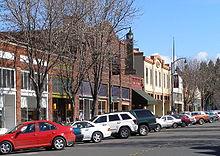
Santa Rosa can be seen as divided into four quadrants: Northeast, Southeast, Southwest, and Northwest. U.S. Route 101 runs roughly north and south through the city, and divides it into east and west sides. State Route 12 runs roughly east and west, and divides the city into north and south sides.
Neighborhoods include:
The 2010 United States Census reported that Santa Rosa had a population of 167,815. The population density was 4,043.8 people per square mile (1,561.3/km ²). The racial makeup of Santa Rosa was: 119,158 (71.0%) White (59.7% non-Hispanic white), 4,079 (2.4%) African American, 2,808 (1.7%) Native American, 8,746 (5.2%) Asian (1.0% Filipino, 1.0% Chinese, 0.8% Vietnamese, 0.6% Indian, 0.5% Cambodian, 0.5% Laotian, 0.3% Japanese, 0.3% Korean, >0.1% Thai, >0.1% Nepalese), 810 (0.5%) Pacific Islander (0.2% Fijian, 0.1% Samoan, >0.1% Hawaiian, >0.1% Guamanian), 23,723 (14.1%) from other races, 8,491 (5.1%) from two or more races. Hispanic or Latino of any race were 47,970 persons (28.6%). Among the Hispanic population, 25.0% of Santa Rosa is Mexican, 0.8% Salvadoran, and 0.4% Puerto Rican.
The Census reported that 164,405 people (98.0% of the population) lived in households, 1,697 (1.0%) lived in non-institutionalized group quarters, and 1,713 (1.0%) were institutionalized.
There were 63,590 households, out of which 20,633 (32.4%) had children under the age of 18 living in them, 27,953 (44.0%) were opposite-sex married couples living together, 7,663 (12.1%) had a female householder with no husband present, 3,615 (5.7%) had a male householder with no wife present. There were 5,020 (7.9%) unmarried opposite-sex partnerships, and 757 (1.2%) same-sex married couples or partnerships. 18,021 households (28.3%) were made up of individuals and 7,474 (11.8%) had someone living alone who was 65 years of age or older. The average household size was 2.59. There were 39,231 families (61.7% of all households); the average family size was 3.18.
The population was spread out with 39,217 people (23.4%) under the age of 18, 15,982 people (9.5%) aged 18 to 24, 46,605 people (27.8%) aged 25 to 44, 43,331 people (25.8%) aged 45 to 64, and 22,680 people (13.5%) who were 65 years of age or older. The median age was 36.7 years. For every 100 females there were 95.2 males. For every 100 females age 18 and over, there were 92.2 males.
There were 67,396 housing units at an average density of 1,624.0 per square mile (627.0/km ²), of which 34,427 (54.1%) were owner-occupied, and 29,163 (45.9%) were occupied by renters. The homeowner vacancy rate was 2.0%; the rental vacancy rate was 5.0%. 87,244 people (52.0% of the population) lived in owner-occupied housing units and 77,161 people (46.0%) lived in rental housing units.
Santa Rosa's Hispanic population, mainly of Mexican descent, while spread out through the city, is mainly concentrated within the western part of Santa Rosa. The highest percentage of Hispanic residents in Santa Rosa is in the Apple Valley Lane/Papago Court neighborhood, at 87%.
The Southeast Asian communities, mainly Vietnamese, Laotian, and Cambodian, are mainly concentrated within the western Santa Rosa neighborhoods of Bellevue Ranch, Roseland, and West Steele areas. The northeast neighborhoods of Skyhawk and Fountaingrove have the most populous Chinese communities.
As of the census of 2000, there were 63,153 households out of which 30.9% had children under the age of 18 living with them, 46.9% were married couples living together, 11.0% had a female householder with no husband present, and 37.3% were non-families. 27.8% of all households were made up of individuals and 11.9% had someone living alone who was 65 years of age or older. The average household size was 2.57 and the average family size was 3.14.
In the city the population is spread out with 24.3% under the age of 18, 9.5% from 18 to 24, 30.0% from 25 to 44, 22.3% from 45 to 64, and 13.9% who are 65 years of age or older. The median age is 36 years. For every 100 females there are 95.4 males. For every 100 females age 18 and over, there are 91.8 males.
The median income for a household in the city is $50,931, and the median income for a family is $59,659. Males have a median income of $40,420 versus $30,597 for females. The per capita income for the city is $24,495. 8.5% of the population and 5.1% of families are below the poverty line. Out of the total population, 9.5% of those under the age of 18 and 4.7% of those 65 and older are living below the poverty line.
In the state legislature Santa Rosa is located in the 2nd Senate District, represented by Democrat Noreen Evans, and in the 7th Assembly District, represented by Democrat Michael Allen. Federally, Santa Rosa is located in California's 6th congressional district, which has a Cook PVI of D +23 and is represented by Democrat Lynn Woolsey.
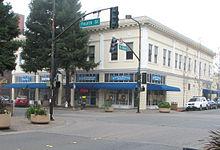
Horticulturalist Luther Burbank lived in Santa Rosa for over 50 years. He said of Sonoma County, "I firmly believe, from what I have seen, that this is the chosen spot of all this earth as far as Nature is concerned." For many years the City's slogan was "The City Designed For Living."
In early 2007, the Santa Rosa Chamber of Commerce, the City, and Santa Rosa Main Street (a Downtown booster group funded by the City), started searching for a new slogan, to "help the City of Santa Rosa discover its identity." The Chamber said it wants to develop "a strategic community message for marketing the city to visitors, residents, and businesses in the year 2007 and beyond."
The Sonoma State University Library, in Rohnert Park, holds the Gaye LeBaron Collection: 700 file folders of her research notes and primary source materials, containing some 10,000 documents.
The City Council has adopted these Strategic Planning Goals for 2007 ae2009:
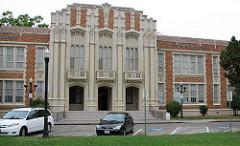
Colleges
School districts
Private schools
The Sonoma County Library offers a Central Library in downtown Santa Rosa, a Northwest branch at Coddingtown Mall, and a Rincon Valley branch in east Santa Rosa. The Library is a member of the North Bay Cooperative Library System. The Santa Rosa Central Library, the largest branch of the Sonoma County Library system, has a Local History and Genealogy Annex, located behind the Central Library.
The Sonoma County Public Law Library is located at the Sonoma County Courthouse.
At Santa Rosa Junior College, the new four-story Frank P. Doyle Library is a state-of-the-art facility. It houses the Library, Media Services, and Academic Computing Departments, as well as the College art gallery, tutorial center and Center for New Media, a multimedia production facility for SRJC faculty.
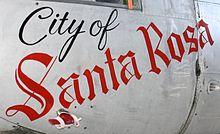
Forbes Magazine ranked the Santa Rosa metropolitan area 185th out of 200, on its 2007 list of Best Places For Business And Careers. It was second on the list five years before. The area was downgraded because of an increase in the cost of doing business, and reduced job growth aeboth blamed on increases in the cost of housing.
According to the City's 2009 Comprehensive Annual Financial Report, the top employers in the city are:
Santa Rosa is also home to notable smaller businesses such as Moonlight Brewing Company and Russian River Brewing Company.
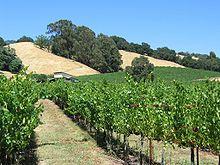
Santa Rosa sits at the northwestern gateway to the Sonoma and Napa Valleys of California's famed Wine Country. Many wineries and vineyards are nearby, as well as the Russian River resort area, the Sonoma Coast along the Pacific Ocean, Jack London State Historic Park and the redwood trees of Armstrong Redwoods State Reserve.
The city sprawls along Highway 101, about an hour north of San Francisco and the Golden Gate Bridge. Airline service by Horizon Air, from the Charles M. Schulz - Sonoma County Airport, just north of Santa Rosa, is available to Las Vegas, Los Angeles, Portland, and Seattle. The City Council is also encouraging major new commercial and residential development along the planned Sonoma-Marin Area Rail Transit (SMART) railway from Larkspur to Cloverdale, parallel to Highway 101. SMART, scheduled to open in 2014, is funded by a sales tax surcharge passed by Sonoma and Marin voters in 2008.
The City Council pays the Santa Rosa Chamber of Commerce to operate the Santa Rosa Convention & Visitors Bureau. The Chamber's visitors center is in the city-owned old railroad depot at the bottom of Fourth Street, in Historic Railroad Square. The SRC&VB has been a California Welcome Center since 2003.
Downtown Santa Rosa, including the central Old Courthouse Square and historic Railroad Square, is a shopping, restaurant, nightclub, and theater area. Downtown also includes City Hall, State, and Federal office buildings, many banks, and professional offices. The Santa Rosa Memorial Hospital medical center is just to the east.
The City Council funds a private booster group, Santa Rosa Main Street, which lobbies the city to revitalize the traditional business district. Three new mixed-use, high-rise buildings, and a new city parking garage, are under development. The Council and downtown business boosters hope condos atop the new buildings will house a population to keep the area active 24 hours a day.
The nearby towns of Bodega Bay, Calistoga, Guerneville, Healdsburg, Petaluma, Sebastopol, Sonoma and Windsor are popular with tourists and readily accessible from Santa Rosa.
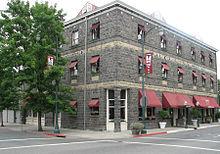
Railroad Square is the portion of downtown that is on the west side of U.S. Route 101 and has the highest concentration of historic commercial buildings. Of particular note are the four rough-hewn stone buildings at its core, two of which are rare in that they predate the 1906 earthquake. They include the old Northwestern Pacific Railroad depot, prominently seen in the beginning and the end of the Alfred Hitchcock film Shadow of a Doubt, and the still-functioning Hotel La Rose, built in 1907 and registered as one of the National Trust for Historic Preservation Historic Hotels of America. The area contains numerous other historic buildings, such as the former Petaluma and Santa Rosa Railroad depot, and the Lee Bros. Building, both at the corner of 4th and Wilson Streets. Near it in the West End district are numerous other old buildings, including not only many old houses but the masonry DeTurk Winery complex, dating to the 1880s-1890s, and the DeTurk round barn. Also of note nearby is the former Del Monte Cannery Building, built in 1894. One of the oldest surviving commercial buildings in town, it was renovated into the 6th Street Playhouse in 2005.
Local attractions
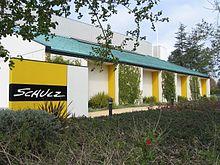
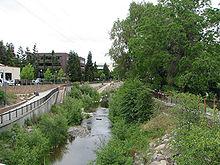
The performing arts in Santa Rosa are represented by Summer Repertory Theatre, the Santa Rosa Symphony, and the 6th Street Playhouse. Santa Rosa is the home of the North Bay Theater Group, an alliance of some 40 theater companies, theater departments and individual performance companies from five North Bay counties.
Summer Repertory Theater (SRT) is a complete and extensive practicum in all aspects of stage production. The program combines professional directing, design, and production staff with outstanding students in acting, design, technical theater, dance, music, and management. The ensemble mounts five productions, which are performed in full rotating Repertory six days a week beginning in mid June. Company members put theory to the test and learn to work in a professional system. SRT, located in the heart of the Sonoma County wine country, one hour north of San Francisco and forty-five minutes east of the beautiful Northern California coast is a well organized program.
The 85-year-old Santa Rosa Symphony Orchestra performs at Green Music Center in Rohnert Park, a new venue with traditional "shoebox" acoustics. Its education department supports four youth ensembles and provides classical music education to students across Sonoma County. Bruno Ferrandis serves as music director, replacing Jeffrey Kahane who held the post for ten years.
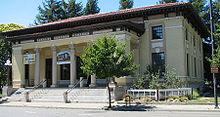
The visual arts are represented by the Sonoma County Museum and numerous independent art galleries. The Arts Council of Sonoma County is based at the Museum.
The Santa Rosa Police Department currently has 259 employees, of which 172 are sworn peace officers. Its budget is more than $40,000,000, comprising more than one third of the city's entire General Fund Budget. Police shootings in 2007 led to calls for an independent civilian police review board.
Neighborhoods such as South Park and Roseland in south Santa Rosa, and Apple Valley in northeast Santa Rosa are most vulnerable to criminal activity. Acts of crime in these neighborhoods are commonly burglaries, graffiti, and violent gang activity. Mexican American street gangs such as Surenos and Nortenos have large concentrations throughout Santa Rosa. A chapter of the Asian Boyz is present in west Santa Rosa.
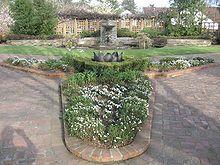

Santa Rosa has served as a location for many major films, including:

Word Count: 4503






